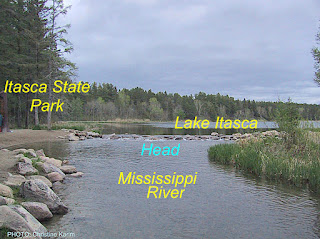• Headwaters: Webster has no listing [it was not a word in use in New England in the early 1800s—today the word means “the source of a river” or “the furthest place in a river or stream from its estuary [mouth] or confluence with another river”].
• Head: The principal source of a stream; as the head of the Nile. Thus, the 1828 “head” and today’s “headwaters” are the same word with the same meaning (source of a river).
• Confluence: A flowing together, meeting or junction of two or more streams, place of meeting.
• Conflux: A flowing together, a meeting of two or more currents of a river (fluid). “Conflux,” by the way, is the same as “confluence,” and in some types of writing, is used interchangeably.
These words each have meaning and are used daily in such disciplines as hydrology, which studies the flow patterns of confluences and how they give rise to patterns of erosion, sand bars, and scour pools; and in chemistry, because sometimes the mixing of the waters of two streams triggers a chemical reaction, particularly in a polluted stream.
Lake Itasca and the head or headwaters
of the Mississippi River in Minnesota
However, Rod Meldrum, in his greater confessed wisdom, says “So the ‘head’ of the Sidon river of the Book of Mormon has two possible definitions, one at the commencement of a stream or river and one which is defined as the location where two branches or tributaries of a river meet, or their confluence.”
Yet, as stated above, the official and overall understanding of rivers is that a river has one “head” and that is where it begins (also called its source, head water, or just head). In fact, in the days of the Nephites, the Sidon River would have been called such throughout its length, no matter if there were tributaries or not. The ancients did not give different names to a river of a land—only other people in other lands would have named a river differently (as an example, early settlers along the course of the Mississippi called the entire river by that name from Itasca, Minnesota, to the Gulf of Mexico; also, though we call the Allegheny River and the Ohio River by these two names today, the Iroquiois understood that to be one river and called it Ohí:o; also the early settlers called the entire Tennessee River by one name, distant Indian groups gave it many names: Chaovannon, Kallamuchee, Kaskinampo, Callamaco, Cootela, Hogohegee, Pellissippi, Nonachunkeh, or Euphasee – depending on which tributary they honored as the main branch.
Yet, Meldrum goes on: “Which definition did the Book of Mormon authors and translator mean and is there a scriptural basis for the idea of the ‘head’ of a river being a junction of two or more rivers?
Left: Two rivers becoming one or
flowing together, with the predominant or main stem river (River A) continuing
along its channel, and the lesser river (River B) ending or flowing into the
other; Right: One river becoming two, or a second river created, with the
predominant or main stem river (River A) continuing along its channel, and the
new river (River B) forming and becoming a new channel with a different or new
name
The first example is seen where the Ohio River terminates at the confluence with the Mississippi River, with the Ohio forming its mouth (end) and the Mississippi river continuing on its channel.
The Mississippi River (Red Line),
continues past this (Yellow Circle) confluence and on through Louisiana for 335
miles to its mouth in the Gulf of Mexico. At Simmesport, Avoyelles Parish,
Louisiana, the distributary Atchafalaya River (green Line) branches off the
Mississippi (creating the Head of the Atchafalaya) and flows to the west then
south and runs about 170 miles basically parallel to the Mississippi to Morgan
City, then into the Gulf of Mexico forming its mouth. The terminology of the
Mississippi does not change
Other confluences connected to the Mississippi River is where the Missouri River flows into it at Jones-Confluence Point State Park, just north of St. Louis, Missouri; upriver the Illinois River flows into the Mississippi; and at Keokuk, Iowa, (just south of Zarahemla, Iowa) the Des Moines River flows into the Mississippi. In addition, the Madison, Jefferson and Gallatin rivers form a confluence with the Missouri River at Three Forks, Montana.
When a river flows into another and
terminates at the confluence, it does not continue its name, and the river
ends, creating its mouth (ending) and the main stem or predominant river
continues on its channel, maintaining its name from before (above) and after
(below) the confluence
The beginning or head of the Ohio
River is formed at the confluence of the Allegheny and Monongahela rivers in
Pittsburg, Pennsylvania, where the northern rivers both end, with their mouths
at the confluence and the head of the Ohio
(See the next post, “The Head, Source, or Headwaters of the Sidon – Part II,” to continue with the understanding of how rivers are categorized with “head,” “tributary,” “distributary,” “confluence,” and “mouth”)









No comments:
Post a Comment